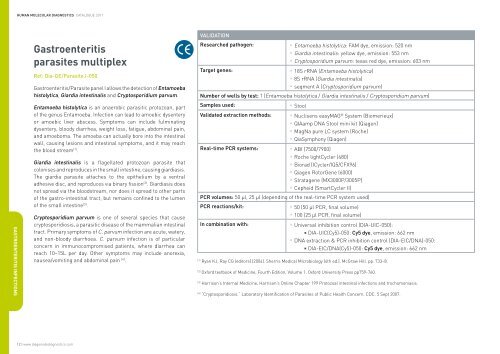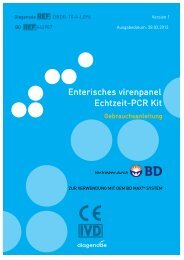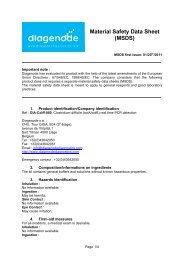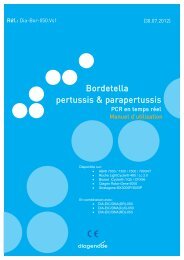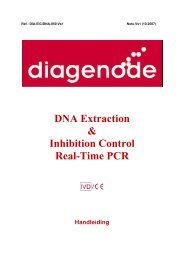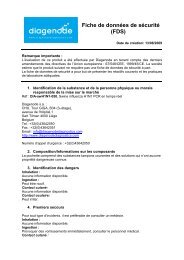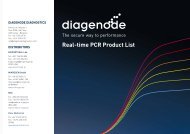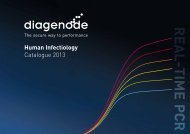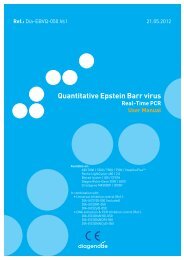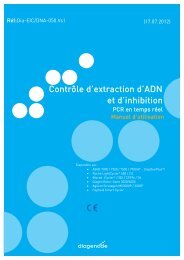HUMAN MOLECULAR DIAGNOSTICS CATALOGUE <strong>2011</strong>GASTROENTERITIS INFECTIONSGastroenteritisparasites multiplexRef: Dia-GE/Parasite.I-050Gastroenteritis/Parasite panel I allows the detection of Entamoebahistolytica, Giardia intestinalis and Cryptosporidium parvum.Entamoeba histolytica is an anaerobic parasitic protozoan, partof the genus Entamoeba. Infection can lead to amoebic dysenteryor amoebic liver abscess. Symptoms can include fulminatingdysentery, bloody diarrhea, weight loss, fatigue, abdominal pain,and amoeboma. The amoeba can actually bore into the intestinalwall, causing lesions and intestinal symptoms, and it may reachthe blood stream (1) .Giardia intestinalis is a flagellated protozoan parasite thatcolonises and reproduces in the small intestine, causing giardiasis.The giardia parasite attaches to the epithelium by a ventraladhesive disc, and reproduces via binary fission (2) . Giardiasis doesnot spread via the bloodstream, nor does it spread to other partsof the gastro-intestinal tract, but remains confined to the lumenof the small intestine (3) .Cryptosporidium parvum is one of several species that causecryptosporidiosis, a parasitic disease of the mammalian intestinaltract. Primary symptoms of C. parvum infection are acute, watery,and non-bloody diarrhoea. C. parvum infection is of particularconcern in immunocompromised patients, where diarrhea canreach 10–15L per day. Other symptoms may include anorexia,nausea/vomiting and abdominal pain (4) .VALIDATIONResearched pathogen:Target genes:• Entamoeba histolytica: FAM dye, emission: 520 nm• Giardia intestinalis: yellow dye, emission: 553 nm• Cryptosporidium parvum: texas red dye, emission: 603 nm• 18S rRNA (Entamoeba histolytica)• 8S rRNA (Giardia intestinalis)• seqment A (Cryptosporidium parvum)Number of wells by test: 1 (Entamoeba histolytica / Giardia intestinalis / Cryptosporidium parvum)Samples used:• StoolValidated extraction methods: • Nuclisens easyMAG ® System (Biomerieux)• QIAamp DNA Stool mini kit (Qiagen)• MagNa pure LC system (Roche)• QiaSymphony (Qiagen)Real-time PCR systems: • ABI (7500/7900)• Roche lightCycler (480)• Biorad (ICycler/IQ5/CFX96)• Qiagen RotorGene (6000)• Stratagene (MX3000P/3005P)• Cepheid (SmartCycler II)PCR volumes: 50 µl, 25 µl (depending of the real-time PCR system used)PCR reactions/kit:• 50 (50 µl PCR, final volume)• 100 (25 µl PCR, final volume)In combination with:• Universal inhibition control (DIA-UIC-050):DIA-UIC(Cy5)-050: Cy5 dye, emission: 662 nm• DNA extraction & PCR inhibition control (DIA-EIC/DNA)-050:DIA-EIC/DNA(Cy5)-050: Cy5 dye, emission: 662 nm(1)Ryan KJ, Ray CG (editors) (2004). Sherris Medical Microbiology (4th ed.). McGraw Hill. pp. 733–8.(2)Oxford textbook of Medicine, Fourth Edition, Volume 1. Oxford University Press pp759-760.(3)Harrison’s Internal Medicine, Harrison’s Online Chapter 199 Protozoal intestinal infections and trochomoniasis.(4)”Cryptosporidiosis.” Laboratory Identification of Parasites of Public Health Concern. CDC. 5 Sept 2007.12 | www.diagenodediagnostics.com
Gastroenteritisviruses multiplexRef: Dia-GE/Virus.I-050Gastroenteritis/virus panel I allows the detection of Astrovirus,Rotavirus A, Norovirus 1 and 2 and Adenovirus.Astrovirus has a non-segmented, single stranded, positivesense RNA genome within a non-enveloped icosahedral capsid (1) .Astroviruses are now recognised as a cause of gastroenteritis inchildren and adults. The main symptoms are diarrhea, followedby nausea, vomiting, fever, malaise and abdominal pain. Someresearch studies have shown that the duration of the symptomsare approximately three to four days. Astrovirus infection is notusually a severe situation and only in some rare cases leads todehydrationRotavirus is the most common cause of severe diarrhea amonginfants and young children (2) , and is one of several viruses thatcause infections often called stomach flu, despite having norelation to influenza. It is a genus of double-stranded RNA virus inthe family Reoviridae. By the age of five, nearly every child in theworld has been infected with rotavirus at least once (3) . However,with each infection, immunity develops, subsequent infectionsare less severe (4) , and adults are rarely affected (5) . There are fivespecies of this virus, referred to as A, B, C, D, and E. RotavirusA, the most common, causes more than 90% of infections inhumans.Norovirus is an RNA virus that causes approximately 90% ofepidemic non-bacterial outbreaks of gastroenteritis around theworld (6) , and may be responsible for 50% of all foodborne outbreaksof gastroenteritis in the US (7) . Norovirus affects people of all ages.The viruses are transmitted by faecally contaminated food orwater, by person-to-person contact (8) and via aerosolization of thevirus and subsequent contamination of surfaces (9) .Adenovirus is a nonenveloped icosahedral virus composed ofa nucleocapsid and a double-stranded linear DNA genome.There are 53 described serotypes in humans and gastroenteritisis mainly caused by serotypes 40 and 41. Some people withadenovirus gastroenteritis may shed the virus in their stools formonths after getting over the symptoms.VALIDATIONResearched pathogen:Target genes:• Astrovirus: FAM dye, emission: 520 nm• Norovirus 1: Yellow dye, emission: 553 nm• Norovirus 2: Yellow dye, emission: 553 nm• Rotavirus A: Texas red dye, emission: 603 nm• Adenovirus: FAM dye, emission: 520 nm(RNA extraction & PCR inhibition control: Cy5, emission: 662 nm)(DNA extraction & PCR inhibition control: Cy5, emission: 662 nm)• ORF1a (Astrovirus)• RdRp/Capsid junction (Norovirus 1)• RdRp/Capsid junction) (Norovirus 2)• NSP3 (Rotavirus A)• Hexon (Adenovirus)Number of wells by test: 21. Astrovirus / Norovirus 1 / Rotavirus A / RNA extraction & PCR inhibition control2. Adenovirus / Norovirus 2 / DNA extraction & PCR inhibition controlSamples used:• StoolValidated extraction methods: • Nuclisens easyMAG ® System (Biomerieux)• QIAamp DNA Stool mini kit (Qiagen)• MagNa pure LC system (Roche)Real-time PCR systems: • ABI (7500/7900)• Roche lightCycler (480)• Biorad (ICycler/IQ5/CFX96)• Qiagen RotorGene (6000)• Stratagene (MX3000P/3005P)• Cepheid (SmartCycler II)PCR volumes: 50 µl, 25 µl (depending of the real-time PCR system used)PCR reactions/kit:• 50 (50 µl PCR)• 100 (25 µl PCR)(1)Matsui SM, Kiang D, Ginzton N, Chew T, Geigenmüller-Gnirke U (2001). «Molecular biology of astroviruses: selected highlights». NovartisFound. Symp. 238: 219–33; discussion 233–6. (2) Dennehy PH (2000). «Transmission of rotavirus and other enteric pathogens in the home».Pediatr. Infect. Dis. J. 19 (10 Suppl): S103–5. (3) Velázquez FR, Matson DO, Calva JJ, Guerrero L, Morrow AL, Carter-Campbell S, Glass RI, EstesMK, Pickering LK, Ruiz-Palacios GM (1996). «Rotavirus infections in infants as protection against subsequent infections». N. Engl. J. Med. 335(14): 1022–8. (4) Linhares AC, Gabbay YB, Mascarenhas JD, Freitas RB, Flewett TH, Beards GM (1988). «Epidemiology of rotavirus subgroups andserotypes in Belem, Brazil: a three-year study». Ann. Inst. Pasteur Virol. 139 (1): 89–99. (5) Bishop RF (1996). «Natural history of human rotavirusinfection». Arch. Virol. Suppl. 12: 119–28. (6) Lindesmith L, Moe C, Marionneau S, et al. (2003). «<strong>Human</strong> susceptibility and resistance to Norwalkvirus infection». Nat. Med. 9 (5): 548–53. (7) Widdowson MA, Sulka A, Bulens SN, et al. (2005). «Norovirus and foodborne disease, United States,1991-2000». Emerging Infect. Dis. 11 (1): 95–102. (8) Goodgame R (2006). «Norovirus gastroenteritis». Curr Gastroenterol Rep 8 (5): 401–8. (9) SaidMA, Perl TM, Sears CL (November 2008). «Healthcare epidemiology: gastrointestinal flu: norovirus in health care and long-term care facilities».Clinical Infectious Diseases : an Official Publication of the Infectious Diseases Society of America 47 (9): 1202–8.13


